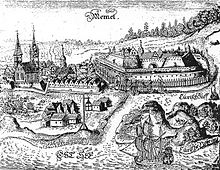Jakobuskirche (Memel)
The Jakobuskirche (Lithuanian Šv. Jokūbo bažnyčia ; until about 1919 St. Nikolaikirche , also Lithuanian church , country church ) was a Protestant church in Memel (Klaipėda) in East Prussia and Lithuania from about 1252 to 1945.
history
The Church of St. Nikolai was probably founded soon after Memel Castle was conquered by the Livonian Order in 1252 as the first parish church in the emerging city. In 1258 the newly built church of St. John was subordinated to her as a daughter church. The Nikolaikirche was mainly set up for the Prussian and Kurish-speaking , later also the Lithuanian population of the city and numerous villages in the area, while the Johanniskirche was for the German-speaking citizens. In the Middle Ages, the sermons were apparently held in German and translated into the local languages by Tolken .
The church had been Protestant since around 1525. In 1620 a separate Lithuanian community was formed. After the destruction by Swedish troops, a new church was built in a new location from 1686 to 1687.
In 1821 it was determined that first one service should be held in German, then one in Lithuanian. (This practice may have existed before that.) After the town fire of 1854, a new church was built in 1855 according to plans by Friedrich August Stüler . In 1858 the Nikolaikirche was designated as a country church for the surrounding villages, while the Johanneskirche became a town church .
After the city of Memel became part of the new Lithuanian state in 1919, it was renamed the St. James Church . There was still a German-speaking and a Lithuanian-speaking Protestant congregation there. In 1938 there was still a German and a Lithuanian confirmation group.
In 1944/45 the church was badly damaged and the remains were removed in 1945.
architecture
The building from 1855 was a wide hall in the neoclassical style based on plans by Friedrich August Stüler. The outside walls were painted white. There was no tower, the three bells were attached to the entrance on the roof.
Inside there was an altar, a pulpit, a baptismal font and church stalls. Friedrich Ladegast's organ from 1858 had 44 registers with three manuals and a pedal.
Web links
- Jakobuskirche Memel Genealogy.net, with detailed history and photos
- Jakobuskirche Eleidiniai, with photos (German, with Lithuanian version)

